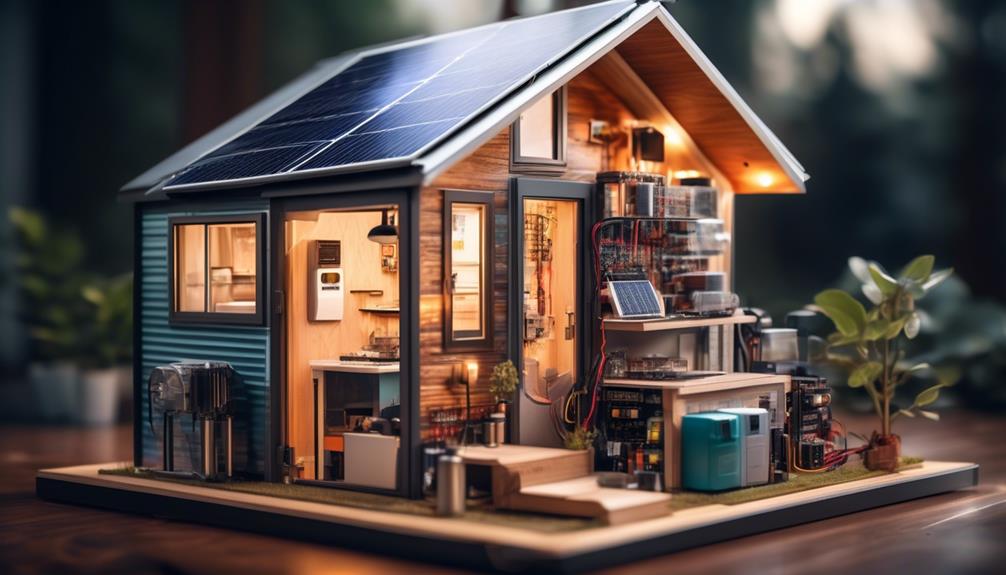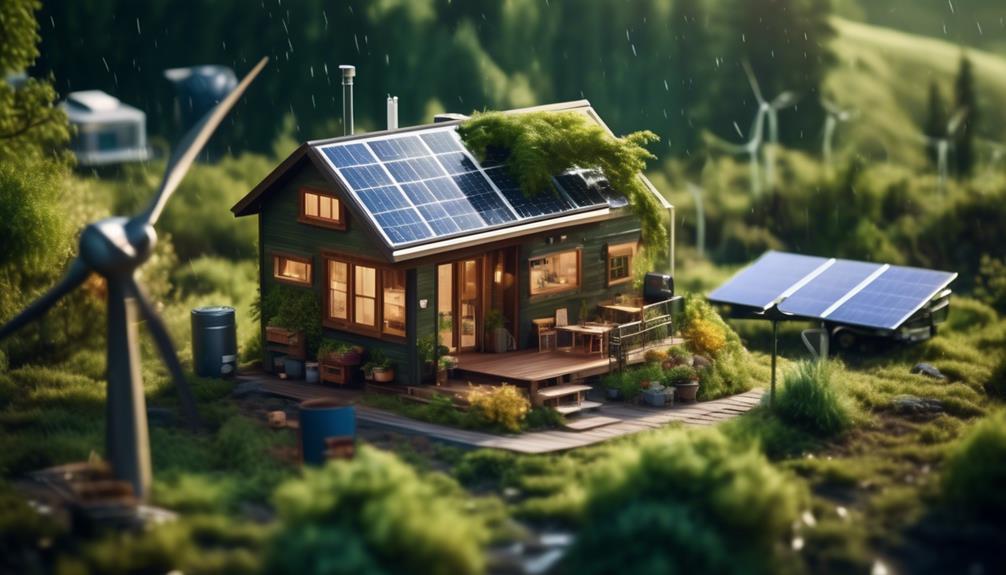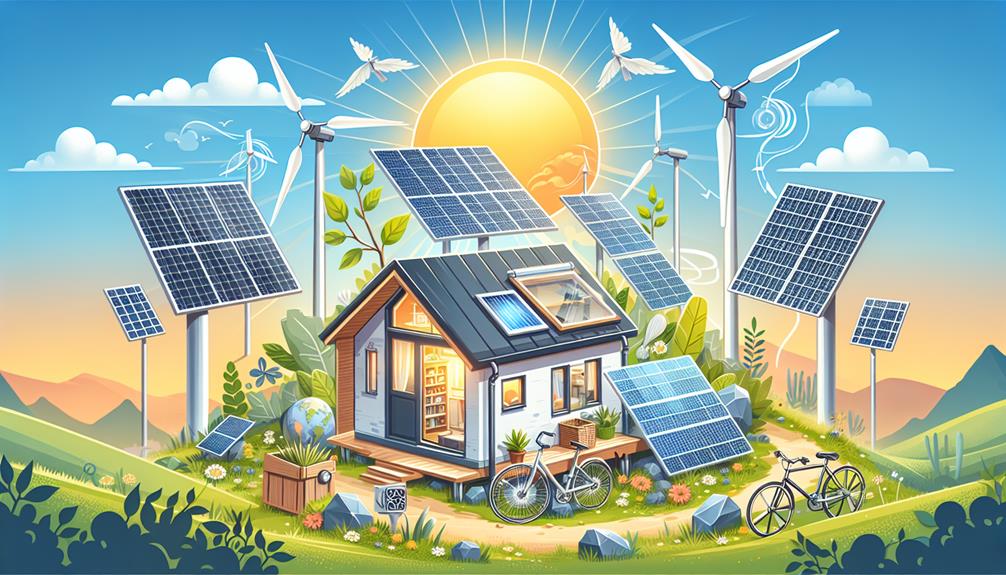Nearly 70% of tiny house owners live without a mortgage, but powering your home still comes with its own set of challenges and costs.
You've taken the big leap into small living, and now you're faced with the task of ensuring your home is adequately powered. Whether you're considering the independence of solar panels or pondering the reliability of grid connection, you need to understand the nuances of each option.
As you weigh the pros and cons, it's crucial to factor in the electrical codes, consumption rates, and even the potential for energy-saving technologies that could streamline your lifestyle.
Join us as we explore the intricacies of tiny home electrification, where you'll discover not just how to keep your lights on, but also how to optimize your energy usage for a sustainable and comfortable living experience.
Key Takeaways
- Familiarize yourself with the National Electrical Code (NEC) and local regulations for safety and compliance.
- Calculate your power consumption meticulously, considering amps, volts, and watts.
- Explore solar power as an off-grid solution for self-sufficient energy in tiny homes.
- Choose between on-grid and off-grid power options based on energy needs and lifestyle preferences.
Understanding Tiny House Electrification
Grasping the intricacies of tiny house electrification begins with familiarizing yourself with the National Electrical Code (NEC) and adhering strictly to both it and local regulations to ensure safety and compliance.
Your Tiny House Electrical system's backbone is the breaker box, which must handle your electrical usage safely. To innovate within these confines, calculate your power consumption meticulously, considering the amps, volts, and watts your lifestyle demands.
Explore solar power as an off-grid solution; a solar panel array, paired with an efficient inverter and batteries, can meet your needs sustainably. When wiring, use the NEC's symbols and color coding to maintain clarity.
Assessing Energy Needs and Consumption
You must first calculate your tiny home's energy requirements by analyzing the electrical consumption of each appliance and tallying their combined watts, amps, and volts.
Monitoring your daily energy use patterns is crucial to tailor your system to your lifestyle and reduce inefficiencies.
An accurate assessment ensures you select the right mix of on-grid or off-grid components, balancing cost with sustainability.
Calculate Required Energy
To accurately determine your tiny home's energy requirements, start by analyzing the power consumption of each appliance and tallying the overall electrical demand. Understanding amps, volts, and watts is critical for this assessment.
You'll need to establish whether your Tiny House Power needs will be met with a standard 120-volt or a more robust 240-volt system. Considering the compact nature of Electricity in a tiny dwelling, a 50-amp service at 120 volts might suffice.
Ensure that your wiring and electrical components are compatible with your calculated required energy. If opting for renewable sources, a solar system is a viable option. Solar energy captured by solar panels can offset much power usage, but accurately gauge the necessary capacity to meet your energy demands.
Monitor Consumption Habits
After determining your tiny home's energy requirements, it's essential to continuously monitor your consumption habits to ensure that your usage aligns with the available supply.
Innovatively, solar panels may serve as a primary source, requiring you to understand how much electricity they generate and how this translates to powering your tiny house effectively.
Implementing a system to monitor consumption habits is critical; it provides real-time feedback on energy use, allowing you to adjust behaviors and devices accordingly.
For instance, when AC power is utilized, ensure electricity flows efficiently by using energy-efficient appliances.
In essence, a meticulous analysis of Tiny House Power usage informs whether your solar panels supply enough electricity or if adjustments are necessary to match Much Electricity your lifestyle demands.
Tiny Home Wiring Fundamentals

You must ensure your tiny home's electrical system adheres strictly to the National Electrical Code (NEC) and local standards for safety and efficiency. Accurately calculating your electrical load is critical; you'll need to evaluate the amps, volts, and watts required by your appliances and devices to determine the correct system size.
When designing your electrical system, carefully consider whether on-grid or off-grid solutions best align with your lifestyle and energy consumption patterns.
Wiring Code Compliance
Ensuring your tiny home's electrical system adheres to local wiring codes is a critical step in the construction process that requires a solid understanding of electrical fundamentals and compliance standards.
When wiring your tiny house, consider the following:
- Familiarize yourself with building codes that dictate safe electrical practices for tiny house electrical systems.
- Calculate your power needs in terms of volts, amps, and watts to inform the design of your House Electrical Panel.
- Hire an electrician experienced in code compliance to verify your setup and connect to the power company with confidence.
- Ensure the use of appropriately rated wire gauges, GFCI outlets, and dedicated circuits to meet stringent safety standards.
Navigating the technical landscape of wiring code compliance is non-negotiable for innovative, responsible tiny home living.
Electrical Load Calculations
Having grasped the importance of wiring code compliance, it's crucial to tackle the task of electrical load calculations to tailor your tiny home's energy consumption to its specific needs.
Begin by analyzing the entire tiny house's power demands, considering all appliances and devices. You'll need to understand the basics of amps, volts, and watts to precisely calculate how much energy your tiny home electrical system will require.
Incorporate tiny house wiring diagrams and ensure your breaker box is sized appropriately. For off-grid living, factor in the capacity of solar panels, inverters, and batteries.
Accurate load calculations are paramount for efficiency and safety, ensuring your tiny house remains powered without overloading the system.
System Design Choices
When designing the wiring system for your tiny home, it's crucial to choose between on-grid and off-grid power options based on your energy needs and lifestyle preferences. Here are your system design choices:
- On-Grid Connection: Utilize an extension cord to link with the municipal power source, ensuring access to continuous electricity. Ideal for tiny homes in urban settings or stationed at RV parks.
- Off-Grid Autonomy: Install solar panels as a renewable energy source, paired with batteries and an inverter, for self-sufficient power.
- Safety Compliance: Integrate special breakers and a reliable ground wire to protect against electrical hazards.
- Hybrid Systems: Consider a combination of on-grid and off-grid solutions to maximize flexibility and energy availability.
Selecting the optimal configuration requires a balance of technical understanding and innovative thinking.
Off-Grid Power Options

For tiny homes situated beyond the reach of conventional power grids, off-grid power options like solar panels, coupled with inverters and batteries, provide a self-sufficient energy solution. You must meticulously monitor your energy consumption, as the capacity of your solar panels and batteries is finite. This sustainable approach demands an up-front investment but yields independence from traditional energy sources.
Here's an analytical overview:
| Component | Function | Consideration |
|---|---|---|
| Solar Panel | Converts sunlight to electricity | Requires optimal placement for maximum efficiency |
| Inverter | Converts DC from panels to AC for household use | Must match the system's voltage and power requirements |
| Battery | Stores electricity for use when solar production is low | Capacity should meet daily energy consumption |
| Temporary Connection | Allows for a backup power cord if needed | Ideal for a tiny house on wheels during relocation |
Ryan Mitchell's principles emphasize that you convert natural resources into usable power, ensuring your tiny home operates seamlessly off-grid.
Grid Connection and Setup
You can connect your tiny home to the grid through a specialized outdoor receptacle and dedicated breaker, ensuring a reliable and compliant power source. When considering the grid connection and setup, you must be mindful of:
- The kind of wire suitable for the specific electrical requirements of your tiny home, matching local codes.
- The cost to wire your tiny home, which varies based on complexity and local labor rates.
- Ensuring power comes from a legitimate source, avoiding double-ended male cords and opting for professional installation.
- Compliance with safety standards, requiring inspections and adherence to electrical regulations.
Choosing the right electrical solutions, including whether to integrate a solar panel system, impacts your grid connectivity. Always prioritize safety, efficiency, and regulatory compliance in your innovative tiny home design.
Energy-Saving Tips and Gadgets

Having established a secure grid connection for your Tiny House, it's crucial to focus on energy-saving strategies and devices that will minimize your power consumption and enhance efficiency. Opt for energy-efficient appliances to cut down on power usage. LED lighting and smart thermostats are essential energy-saving tips and gadgets, providing precise control over your tiny home's environment.
To wire a tiny residence sustainably, consider investing in solar panels coupled with a battery storage system. This setup will need to convert sunlight into a reliable power source, ensuring off-grid capability.
Furthermore, implementing proper insulation, strategic window treatments, and sealing gaps can preserve indoor temperatures, reducing dependency on heating and cooling systems.
Lastly, integrating power strips with timers and energy monitors can help you manage your electrical solutions, keeping your powering your tiny home ambitions innovative and sustainable.
Frequently Asked Questions
What Is the Cheapest Way to Power a Tiny House?
You'll find that connecting to the grid generally presents the most cost-effective solution, leveraging energy conservation and efficiency over solar panels, wind turbines, battery banks, or power generators for innovative tiny house living.
How Do I Get Electricity for My Tiny House?
You'll harness the sun itself with solar panels, store energy in battery banks, convert with power inverters, and supplement with wind turbines or generators—all ensuring your tiny house's energy efficiency is off the charts.
How Do People Power Their Tiny House?
You'll power your tiny house through off-grid options like solar panels, battery storage, or generators, and possibly wind turbines. Emphasize energy efficiency and consider propane systems for heating and cooking.
How Much Power Is Needed to Power a Tiny Home?
You'll need to meticulously chart your energy requirements, assess solar potential, and scrutinize battery capacity. Precise power calculation and efficiency strategies are crucial, as is wise appliance selection and thorough consumption analysis.
Conclusion
In electrifying your tiny abode, you've navigated a labyrinth of codes and calculations. Your diligence ensures that whether you're grid-tied or basking in solar autonomy, safety and efficiency reign.
Embrace energy-saving gadgets—they're not just bells and whistles, but the sinews connecting your sustainable living dreams to reality.
Remember, the power in your tiny home mirrors the power in you: compact, potent, and brilliantly self-sufficient.

